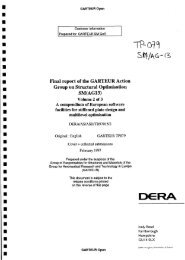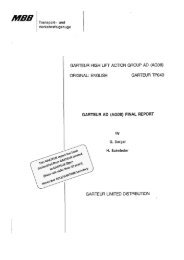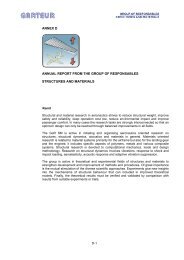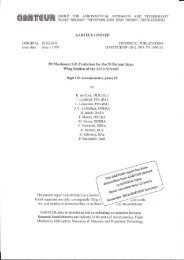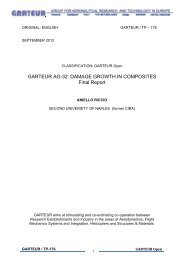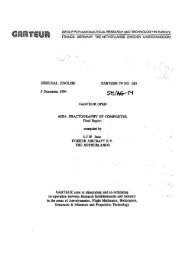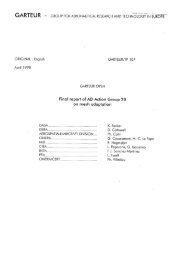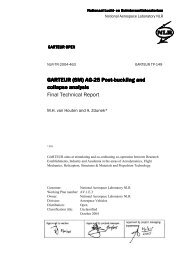Cadmium Substitution - garteur
Cadmium Substitution - garteur
Cadmium Substitution - garteur
Create successful ePaper yourself
Turn your PDF publications into a flip-book with our unique Google optimized e-Paper software.
GARTEUR LIMITED<br />
ANNEX G<br />
Resistance to aircraft chemicals<br />
G.1 Introduction<br />
During an aircraft's operational life it comes into contact with a large number of<br />
chemicals and fluids. These include aviation fuel, engine oils and hydraulic fluids as well<br />
as cleaners and paint strippers used in the maintenance and repair of protective<br />
treatments. The aim of the work described below was to establish whether any of the<br />
cadmium replacements being investigated were likely to degrade on prolonged contact<br />
with some of the commonly used aircraft chemicals.<br />
G.2 Test procedures<br />
Studies of the resistance of replacement coatings to aircraft fluids were carried out by<br />
British Aerospace and Shorts. Details of the fluids examined by each of the organisations<br />
are given in table G1.<br />
G.2.1<br />
British Aerospace<br />
All specimens were subjected to immersion in the above fluids for a period of 7 days.<br />
Following immersion the panels except for the water and Propanol were wiped clean with<br />
a clean cloth moistened with Petroleum spirit and left to dry. The remaining panels were<br />
wiped with a dry clean cloth. On completion of above the panels were visually assessed<br />
using x10 magnification before carrying out microscopic evaluation using an optical<br />
microscope.<br />
G.2.2<br />
Shorts<br />
G.3 Results<br />
Coated panels 100 x 150mm were immersed in the various fluids identified in table G1.<br />
The panels were inspected daily for signs of corrosion attack, coating removal and colour<br />
changes.<br />
Tables G2 and G3 summarise the results obtained from the B.Ae and Shorts studies.<br />
Several of the coatings investigated, including electrodeposited cadmium, were found to<br />
be susceptible to corrosion attack when in contact with the aircraft cleaner Turco 5948.<br />
For ED Zn/Ni (passivated and non-passivated) the cleaner starts to remove the coating<br />
within 24 hours whilst for ED <strong>Cadmium</strong> (passivated and non-passivated) some attack is<br />
apparent after 500h immersion.<br />
Data presented in table G3 further indicate that Skydrol has a detrimental on both<br />
electrodeposited cadmium and zinc-cobalt-iron coatings. In each case a significant<br />
weight loss was recorded.<br />
G.4 Conclusions<br />
Most of the replacement coatings examined failed to show any significant degradation on<br />
exposure to a range of chemicals used on aircraft. Exceptions were ED zinc-nickel<br />
coatings in contact with Turco 5948 and ED zinc-cobalt coatings immersed in Skydrol<br />
hydraulic fluid. <strong>Cadmium</strong> plating was also found to be degraded by these fluids.<br />
G.5 Tables<br />
GARTEUR SM/AG17 TP128 Page 89





